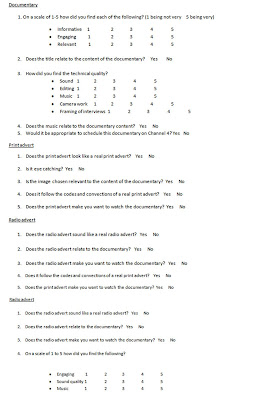Question 3What have you learned from your audience feedback?
The image above is the profile of the tipical person who would watch my documentay, this is because she has an interest in hair and is within the age range we targeted the documentary at.
To collect our audiance feedback we created a questionnair, where we then showed a group of people within out target audience our documentary, radio advert and print advert.
they then filled out the questionnair, this is the questionnair and theses are our results.

I then asked another person on my own from my target audiance to comment on our documentary and ancillary tasks. i used some of the same questions from my questionnair.
This are the overall results of our feedback.
1. On a scale of 1-5 how did you find each of the following? (1 being not very 5 being very)Informative- 4 people that answered with 4 and the other 4 people answered with 5, this allowed our group to know that our production is informative as No one rated our production lower than a four and we got good ratings for the information that is given out in the production.
Engaging- Our classroom feedback showed us that our production was engaging to most of our audience as four people rated our production with a 4 and three people rated it with a 5 and there was only one person who rated us with a 3.
Relevant- The results from the questionnaire feedback show us that the content of our production is relevant to our Title. Four people from the feedback gave us a 4 and the other four gave us a 5.
2. Does the title relate to the content of the documentary? Yes NoFor this answers all the feedback from our audience shows us that our title does relate to the content within the documentary. All 8 of the Audience chose to give us a yes for this answer.
3. How did you find the technical quality?We asked our audience about how they thought the technical quality of our production was and here are the answers:
Sound- Five members of the audience rated our sound quality as a 4 and the other three answered with a 5, this shows that are sound quality isn’t bad as we scored over half marks from the audience.
Editing- Four members of the audience decided to give us a 4 on the editing of the documentary and the other 4 chose to rate us with a 5.
Music- The music within the documentary was used to relate the emotion with the audience, therefore the results show that two people from the audience rated us with a 4 and the other six gave us a 5.
Camera Work- The camera work in our production didn’t get rated high with the audience as one person rated us with a 3, four gave us 4 and three gave us a 5.
Framing- With the framing of interviews in our production we got rated with six people scoring us with a 4 and two people with a 5.
4. Does the music relate to the documentary content? Yes NoAll the audience answered yes for this question, this let us as a group know that we have chosen the correct music for our documentary.
5. Would it be appropriate to schedule this documentary on Channel 4? Yes NoWith this question all members from the audience rated us with a yes; this showed us that our documentary would be suitable to be shown on channel 4.
Print advert
1. Does the print advert look like a real print advert? Yes No2.
Is it eye catching? Yes No3.
Is the image chosen relevant to the content of thedocumentary? Yes No4.
Does it follow the codes and convections of a real print advert? Yes No5.
Does the print advert make you want to watch the documentary? Yes No
With all of these answers all the members of the audience gave us a yes for each question. Our print advert tries to make people want to watch the programme just from seeing it and we believe that that is what it does. The print advert is very bright but also conveys the meaning and emotion that we want it to. We believe that people will understand the picture as it relates to the name of the programme and the slogan brings people in and will make them want to watch the documentary.Radio advert
1. Does the radio advert sound like a real radio advert? Yes No2.
Does the radio advert relate to the documentary? Yes No3.
Does the radio advert make you want to watch the documentary? Yes No
All three of these questions were answered bythe audience and they all answered with a yes. Our radio advert has the most interesting bits of the documentary in them, we believe that this will engage the audience and make them feel like they want to find out what the documentary is about. We have many different parts of the interviews in the radio advert therefore we have many different emotions being brought into the advert.
4. On a scale of 1 to 5 how did you find the following?
Engaging- One person from our audience rated us with a 3, Five people gave us a 4 and the other two rated us with a 5.
Sound Quality- One person answered as a 3, four people gave us a 4 and the other three people answered with a 5.
Music- One person gave us a 3, two people gave us a 4 and the other five rated us with a 5
















